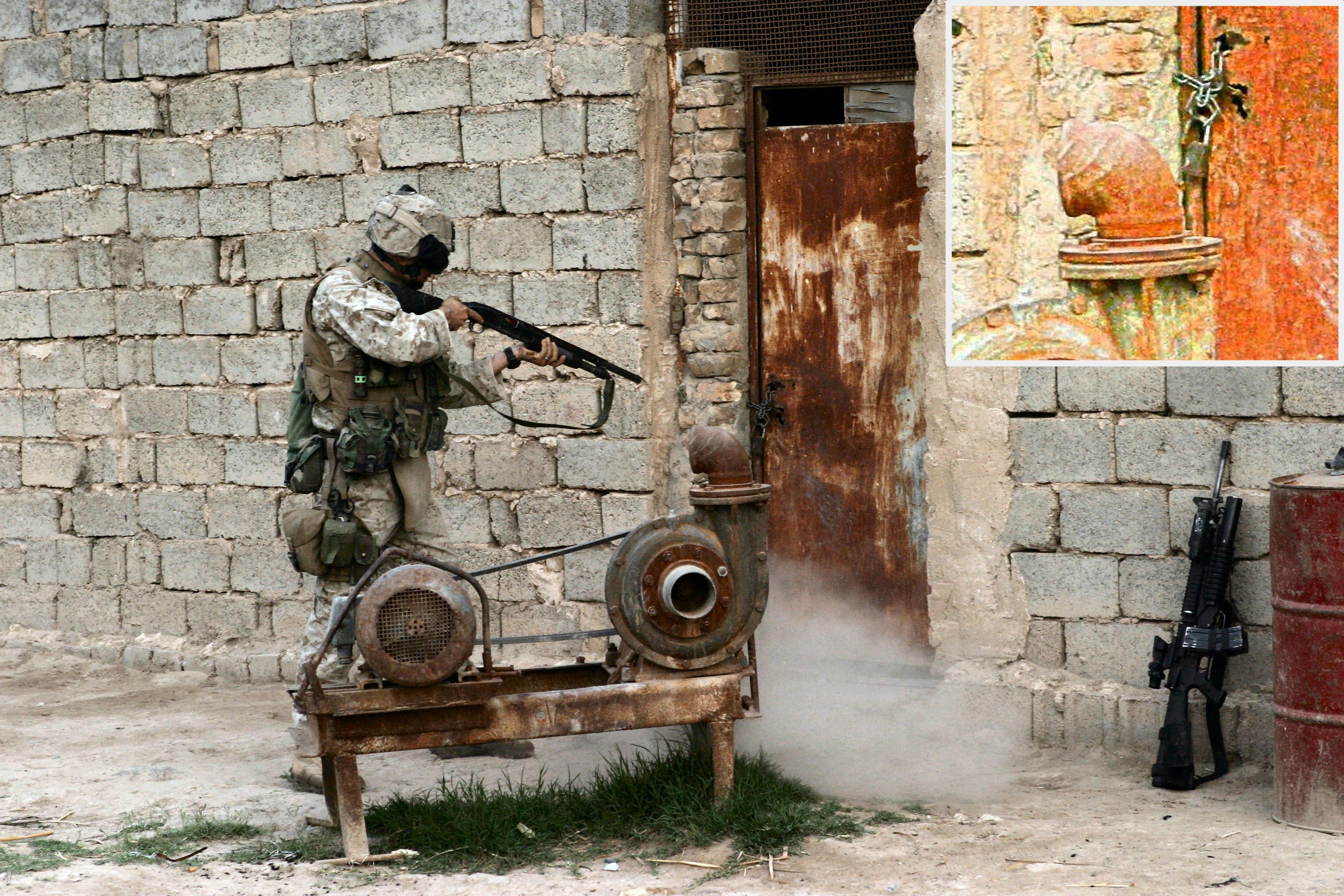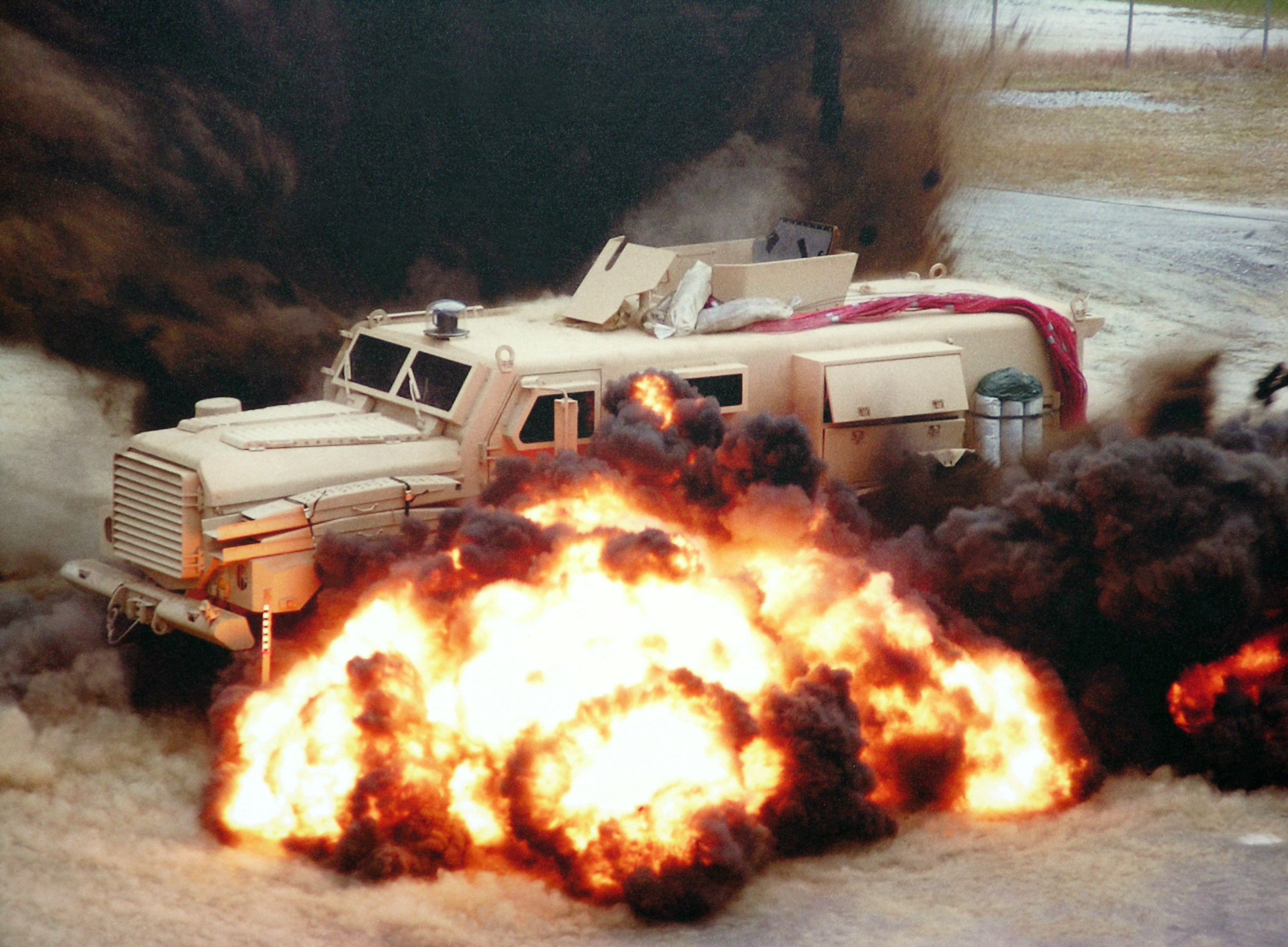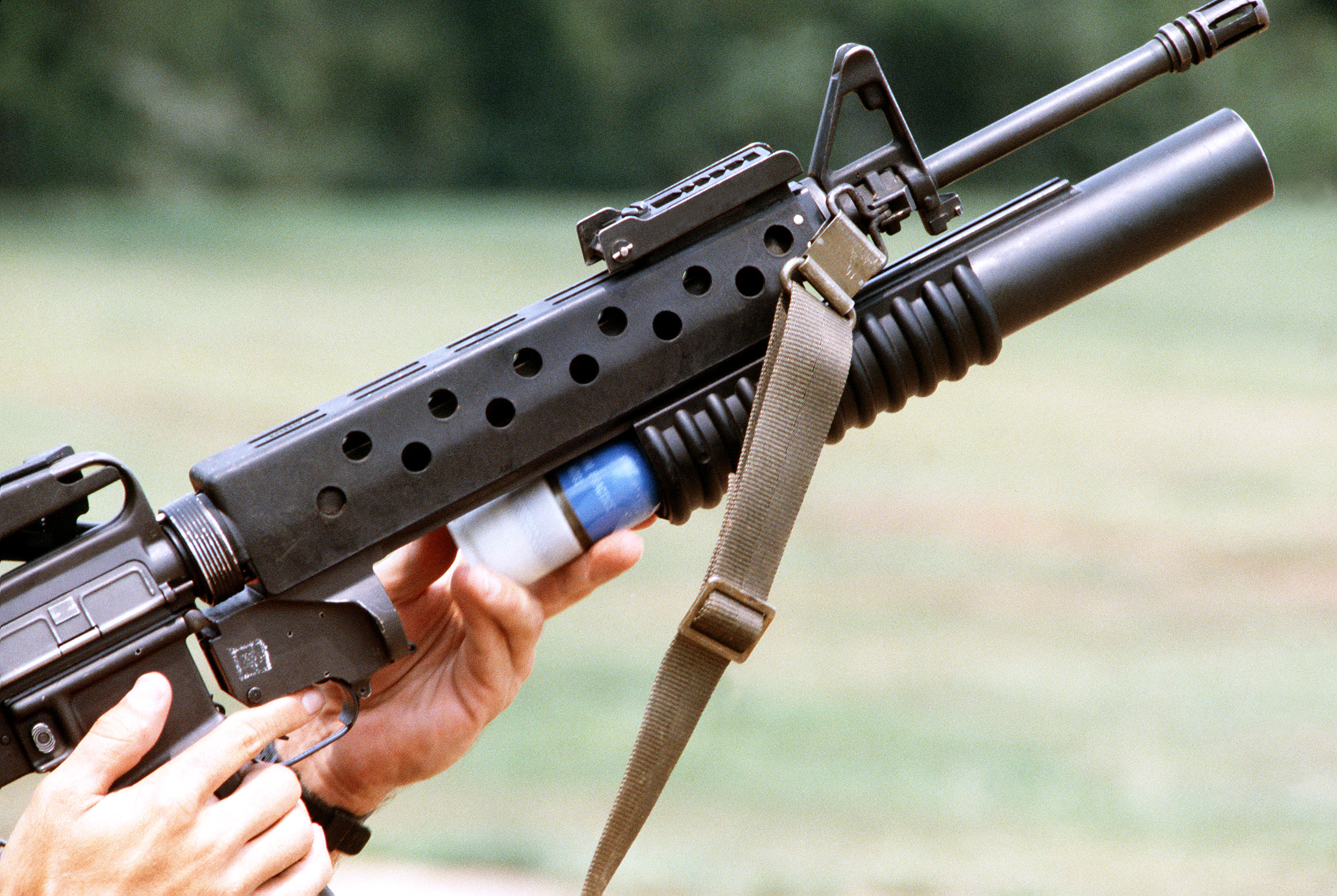|
Weapons Company
A weapons company, sometimes called a manoeuvre support company, is a company-sized military unit attached to an infantry battalion to support the rifle companies of the battalion. It usually possesses some combination of machine-guns, mortars, anti-tank missiles, anti-aircraft missiles, reconnaissance vehicles and, sometimes, assault pioneers (infantrymen specially trained in the assault role). British Army In the British Army, the manoeuvre support company possesses an Anti-Tank platoon armed with 8 Javelin missile launchers, a reconnaissance platoon, a mortar platoon (with eight L16 81mm mortars), an assault pioneer platoon, and, in the case of Light Role battalions, a machine gun platoon (with nine FN MAG general purpose machine guns). United States Marine Corps In the United States Marine Corps, the infantry battalion weapons company is tasked with providing supporting fire for the three rifle companies that (along with the battalion's headquarters and service company) ... [...More Info...] [...Related Items...] OR: [Wikipedia] [Google] [Baidu] |
Company (military)
A company is a military unit, typically consisting of 80–250 soldiers and usually commanded by a major or a captain. Most companies are formed of three to seven platoons, although the exact number may vary by country, unit type, and structure. Usually several companies are grouped as a battalion or regiment, the latter of which is sometimes formed by several battalions. Occasionally, ''independent'' or ''separate'' companies are organized for special purposes, such as the 1st Air Naval Gunfire Liaison Company or the 3rd Force Reconnaissance Company. These companies are not organic to a battalion or regiment, but rather report directly to a higher level organization such as a Marine Expeditionary Force headquarters (i.e., a corps-level command). Historical background The modern military company became popularized during the reorganization of the Swedish Army in 1631 under King Gustav II Adolph. For administrative purposes, the infantry was divided into companies consisting ... [...More Info...] [...Related Items...] OR: [Wikipedia] [Google] [Baidu] |
Headquarters
Headquarters (commonly referred to as HQ) denotes the location where most, if not all, of the important functions of an organization are coordinated. In the United States, the corporate headquarters represents the entity at the center or the top of a corporation taking full responsibility for managing all business activities. In the United Kingdom, the term head office (or HO) is most commonly used for the headquarters of large corporations. The term is also used regarding military organizations. Corporate A headquarters is the entity at the top of a corporation that takes full responsibility for the overall success of the corporation, and ensures corporate governance. The corporate headquarters is a key element of a corporate structure and covers different corporate functions such as strategic planning, corporate communications, tax, legal, marketing, finance, human resources, information technology, and procurement. This entity includes the chief executive officer ... [...More Info...] [...Related Items...] OR: [Wikipedia] [Google] [Baidu] |
Door Breaching
Door breaching is a process used by military, police, or emergency services to force open closed or locked doors. A wide range of methods are available depending on the door's opening direction (inward or outward), construction materials, etc., and one or more of these methods may be used in any given situation. In the United States, residential doors typically open inward while commercial building doors usually open outward. Some breaching methods require specialized equipment and can be categorized as one of the following: mechanical breaching, ballistic breaching, hydraulic breaching, explosive breaching, or thermal breaching. Manual methods The simplest solution is to check the door knob first. Utilizing a breaching tool is unnecessary if the door is unlocked and easy to open. If the door is locked, breachers can attempt to force inward-opening doors with a strong kick. The breacher will aim to hit the door near the locking mechanism, but not kick the doorknob itself as ... [...More Info...] [...Related Items...] OR: [Wikipedia] [Google] [Baidu] |
Demolition
Demolition (also known as razing, cartage, and wrecking) is the science and engineering in safely and efficiently tearing down of buildings and other artificial structures. Demolition contrasts with deconstruction, which involves taking a building apart while carefully preserving valuable elements for reuse purposes. For small buildings, such as houses, that are only two or three stories high, demolition is a rather simple process. The building is pulled down either manually or mechanically using large hydraulic equipment: elevated work platforms, cranes, excavators or bulldozers. Larger buildings may require the use of a wrecking ball, a heavy weight on a cable that is swung by a crane into the side of the buildings. Wrecking balls are especially effective against masonry, but are less easily controlled and often less efficient than other methods. Newer methods may use rotational hydraulic shears and silenced rock-breakers attached to excavators to cut or break through ... [...More Info...] [...Related Items...] OR: [Wikipedia] [Google] [Baidu] |
Ad Hoc
Ad hoc is a Latin phrase meaning literally 'to this'. In English, it typically signifies a solution for a specific purpose, problem, or task rather than a generalized solution adaptable to collateral instances. (Compare with '' a priori''.) Common examples are ad hoc committees and commissions created at the national or international level for a specific task. In other fields, the term could refer to, for example, a military unit created under special circumstances (see '' task force''), a handcrafted network protocol (e.g., ad hoc network), a temporary banding together of geographically-linked franchise locations (of a given national brand) to issue advertising coupons, or a purpose-specific equation. Ad hoc can also be an adjective describing the temporary, provisional, or improvised methods to deal with a particular problem, the tendency of which has given rise to the noun ''adhocism''. Styling Style guides disagree on whether Latin phrases like ad hoc should be italici ... [...More Info...] [...Related Items...] OR: [Wikipedia] [Google] [Baidu] |
MRAP (armored Vehicle)
Mine-Resistant Ambush Protected (MRAP; ) is a term for United States military light tactical vehicles produced as part of the MRAP program that are designed specifically to withstand improvised explosive device (IED) attacks and ambushes. The United States Department of Defense MRAP program began in 2007 as a response to the increased threat of IEDs during the Iraq War. From 2007 until 2012, the MRAP program deployed more than 12,000 vehicles in the War in Iraq and War in Afghanistan. Production of MRAP vehicles officially ended in 2012. This was followed by the MRAP All Terrain (M-ATV) vehicle. In 2015, Oshkosh Corporation was awarded a contract to build the Oshkosh L-ATV as the Joint Light Tactical Vehicle, a lighter mine-resistant vehicle to replace the Humvee in combat roles and supplement the M-ATV. History Light armored vehicles designed specifically to resist land mines were first introduced in specialized vehicles in the 1970s by the Rhodesian Army, and further d ... [...More Info...] [...Related Items...] OR: [Wikipedia] [Google] [Baidu] |
Humvee
The High Mobility Multipurpose Wheeled Vehicle (HMMWV; colloquial: Humvee) is a family of light, four-wheel drive, military trucks and utility vehicles produced by AM General. It has largely supplanted the roles previously performed by the original jeep, and others such as the Vietnam War-era M151 jeep, the M561 "Gama Goat", their M718A1 and M792 ambulance versions, the Commercial Utility Cargo Vehicle, and other light trucks. Primarily used by the United States military, it is also used by numerous other countries and organizations and even in civilian adaptations. The Humvee saw widespread use in the Gulf War of 1991, where it navigated the treacherous desert terrain; this usage helped to inspire civilian Hummer versions. The vehicle's original unarmored design was later seen to be inadequate. The vehicle was found to be particularly vulnerable to improvised explosive devices in the Iraq War. The U.S. hastily up-armored select models and replaced front-line units with ... [...More Info...] [...Related Items...] OR: [Wikipedia] [Google] [Baidu] |
Combined Anti-Armor Team
A Combined Anti-Armor Team or Combined Arms Assault Teams, (CAAT) is an organization of a United States Marine Corps weapons company where one or more platoons are operated in a detached role to conduct reconnaissance missions, combat ground armored vehicles and air defense vehicles with heavy weapons systems. CAATs often use weapon systems such as M2 .50 caliber machine guns, Mk-19 grenade launchers, and anti-armor missile systems such as BGM-71 TOW missiles and/or FGM-148 Javelins . In the Marine Corps, members of a CAAT are typically weapons company infantrymen who receive additional training in the CAAT role as well as cross training in all of the weapons systems employed by the CAAT. In addition to their usual role of dedicated anti-armor operations, CAATs are a vehicle-mounted heavy weapons quick reaction force for the infantry units they support. CAATs may also serve as security elements for a variety of military elements. Personnel A USMC CAAT is composed of 0331 Mac ... [...More Info...] [...Related Items...] OR: [Wikipedia] [Google] [Baidu] |
Grenade Launcher
A grenade launcher is a weapon that fires a specially-designed large-caliber projectile, often with an explosive, smoke or gas warhead. Today, the term generally refers to a class of dedicated firearms firing unitary grenade cartridges. The most common type are man-portable, shoulder-fired weapons issued to individuals, although larger crew-served launchers are issued at higher levels of organisation by military forces. Grenade launchers can either come in the form of standalone weapons (either single-shot or repeating) or attachments mounted to a parent firearm, usually a rifle. Larger crew-served automatic grenade launchers such as the Mk 19 are mounted on tripods or vehicles. Some armored fighting vehicles also mount fixed arrays of short range, single-shot grenade launchers as a means of defense. History Early precursors The earliest devices which could be referred to as grenade launchers were slings, which could be used to throw early ''grenado'' fuse bombs. Th ... [...More Info...] [...Related Items...] OR: [Wikipedia] [Google] [Baidu] |
40 Mm Grenade
40 mm grenade (also styled 40mm grenade) is a generic class-name for grenade launcher ammunition (subsonic shells) in caliber. The generic name stems from the fact that several countries have developed or adopted grenade launchers in 40 mm caliber. This is a general collection of the world's many different "40 mm grenades". NATO NATO currently uses three standardized 40 mm grenade families: 40 mm low velocity (LV), 40 mm medium velocity (MV), and 40 mm high velocity (HV). Low- and medium-velocity cartridges are used for different hand-held grenade launchers, while the high-velocity cartridge is used for automatic grenade launchers. 40×46 mm LV (40 mm low velocity) ''40×46 mm LV'' (''low velocity'') is a NATO-standard high–low grenade launcher cartridge meant for hand-held grenade launchers, such as the M79, M203, Milkor MGL, and Heckler & Koch AG36. The propellant has low pressure and gives the projectile an average velocity of depending on the ammun ... [...More Info...] [...Related Items...] OR: [Wikipedia] [Google] [Baidu] |
Mk 19 Grenade Launcher
The Mk 19 grenade launcher (pronounced Mark 19) is an American 40 mm belt-fed automatic grenade launcher that was first developed during the Vietnam War. Overview The Mk 19 is a belt-fed, blowback-operated, air-cooled, crew-served, fully-automatic weapon that is designed not to cook off. It fires 40 mm grenades at a cyclic rate of 325 to 375 rounds per minute, giving a practical rate of fire of 60 rounds per minute (rapid) and 40 rounds per minute (sustained). The weapon operates on the blowback principle, which uses the chamber pressure from each fired round to load and re-cock the weapon. The Mk 19 can launch its grenade at a maximum distance of , though its effective range to a point target is about , since the large rear leaf sight is only graduated as far. The nearest safe distance to launch the grenade is 310 meters in training and 75 meters in combat. Though the Mk 19 has a flash suppressor, it serves only to save the eyesight of its operat ... [...More Info...] [...Related Items...] OR: [Wikipedia] [Google] [Baidu] |
M2 Browning Machine Gun
The M2 machine gun or Browning .50 caliber machine gun (informally, "Ma Deuce") is a heavy machine gun that was designed towards the end of World War I by John Browning. Its design is similar to Browning's earlier M1919 Browning machine gun, which was chambered for the .30-06 cartridge. The M2 uses Browning's larger and more powerful .50 BMG (12.7 mm) cartridge. The design has had many designations; the official U.S. military designation for the current infantry type is Browning Machine Gun, Cal. .50, M2, HB, Flexible. It is effective against infantry, unarmored or lightly armored vehicles and boats, light fortifications, and low-flying aircraft. The gun has been used extensively as a vehicle weapon and for aircraft armament by the United States since the 1930s. It was heavily used during World War II, the Korean War, the Vietnam War, the Falklands War, the Soviet–Afghan War, the Gulf War, the Iraq War, and the War in Afghanistan. It is the primary heavy machine gun of ... [...More Info...] [...Related Items...] OR: [Wikipedia] [Google] [Baidu] |






.jpg)


